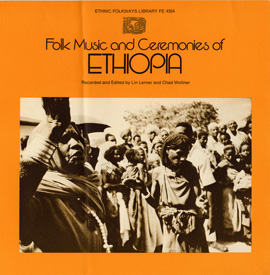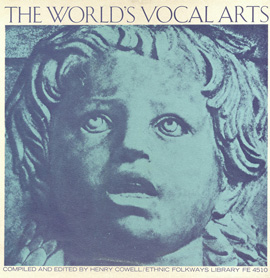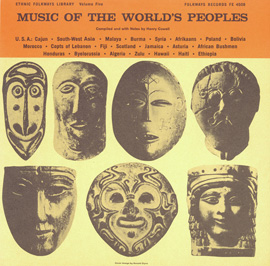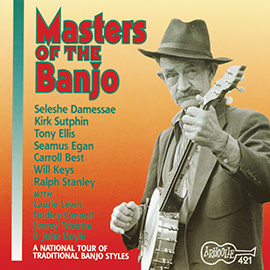Summary
Students will be introduced to the music of Ethiopia through several activities including listening, analyzing, and performing. They will perform arrangements on various instruments, playing intact and together, and will use this material to improvise and compose their own music. Students will become familiar with the Ethiopian Begena, a low pitched stringed instrument that resembles a large lyre.
Suggested Grade Levels: 6-8, 9-12
Country: Ethiopia
Region: Northeast Africa (‘The Horn’)
Culture Group: Tigrai, Somali
Genre: World
Instruments: Begena (Ethiopian string instrument that resembles a large lyre), Voice, Orchestra
Language: Undocumented
Co-Curricular Areas: Social Studies
National Standards: 1, 2, 3, 4, 5, 6, 9
Prerequisites: None
Objectives:
- Understanding the music of Ethiopian Culture
- Basic knowledge of Ethiopian geography, history, and food
- Basic understanding of improvisation
- Basic concepts dealing with musical form
Material:
- “Personal Song” from Folk Music and Ceremonies of Ethiopia (FW04354)
- Liner notes Folk Music and Ceremonies of Ethiopia (FW04354)
- “I Beg You, Heart” from Folk Music of Ethiopia (FW04405)
- Sheet Music to “Personal Song” and “I Beg You, Heart” (Figures 1-4)
- Map of Ethiopia
- Map of the African continent
- Picture of Emperor Haile Selassie I
- Picture of the Begena
Lesson Segments:
- Making Sense of an Ethiopian “Personal Song” (National Standards 1, 2, 5, 6, 9)
- The Musical Complexities of “I Beg You Heart” (National Standards 1, 2, 3, 4, 5, 6, 9)
Lesson Segment 1: Making Sense of an Ethiopian “Personal Song”

“Personal Song (Somali Woman)”
from Folk Music and Ceremonies of Ethiopia (1974) | FW04354
Procedure:
- Play the recording of “Personal Song” from “Folk Music and Ceremonies of Ethiopia”.
- Ask students to listen and describe what they are hearing
- Who is singing? Answer: A woman in a crowd
- Where are we? Answer: Ethiopia
- What clues do we have? Answer: Language, first word is “Haile Selassie”
- Ask students to focus on these questions:
- Is there a steady beat? Answer: There is a beat but it seems non-metrical at times
- Are there repeated melodic ideas? Answer: Yes, m.5-7 she repeats a rhythmic phrase
- What does the singer do to certain notes? Answer: She ornaments them by sliding to a higher note and back
- Direct students to:
- “Draw” with their fingers the high and low pitches of the melody
- Try to sing along with the recording
- Explain the setting of the performance of “Personal Song”.
- Using a map:
- Ask students to listen and describe what they are hearing
- Who is singing? Answer: A woman in a crowd
- Where are we? Answer: Ethiopia
- What clues do we have? Answer: Language, first word is “Haile Selassie”
- Ask students to focus on these questions:
- Is there a steady beat? Answer: There is a beat but it seems non-metrical at times
- Are there repeated melodic ideas? Answer: Yes, m.5-7 she repeats a rhythmic phrase
- What does the singer do to certain notes? Answer: She ornaments them by sliding to a higher note and back
- Direct students to:
- Point out the location of Ethiopia, and name the countries and bodies of water nearby (Egypt, Somalia, Eritrea, the Sudan, the Red Sea)
- Point out the Somali Region of Ethiopia (this region is on the east coast of Ethiopia bordering Somalia and is where the “Personal Song” was recorded)
- Discuss the setting of the text.
- It was recorded at the Emperor’s birthday festival.
- Play recording again but this time listen for the Emperors name (first phrase)
- Traditional chant of the pastoral Somali people.
- Distribute transcription for “Personal Song” (Figure 1) and sing or perform on instruments.
- Sing the melody on a neutral syllable such as ‘la’ or ‘loo’
- Try singing on different syllables
- Discuss pitch material:
- Pentatonic scale
- Discuss complications with transcriptions:
- Flexible rhythm and time
- Possible microtonal
- b. It is a song of praise for Emperor Haile Selassie I.
- b. About the simple virtues of life and how good it is to be alive.
- ii. Try to emulate embellished notes
Assessment:
- Are students able to discuss the material in an age appropriate manner? Are students able to perform the transcription accurately?
Lesson Segment 2. The Musical Complexities of I Beg You Heart
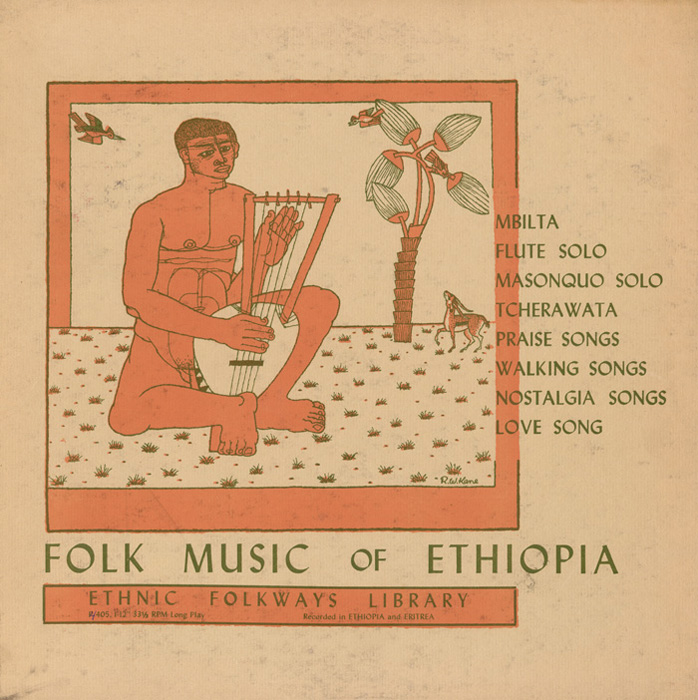
“I Beg You, Heart (Ethiopia)”
from Folk Music of Ethiopia (1951) | FW04405
Procedure:
- Play “I Beg You, Heart” From Folk Music of Ethiopia (FW04405) several times.
- With each repeated listening ask students to listen for something new:
- Timbre
- Metrical/Nonmetrical
- Instruments
- Vocal quality
- Harmony
- Listen only to the voice or vice-versa
- Discuss the meaning of the text.
“I beg you heart,
Get accustomed to it.
I have no family.
I beg you heart,
I have no family,
I beg you, heart,
I have no refuge,
So be you my cavern to live in.”
- Have the students brainstorm the appearance of the Begena as they listen to it.
- Show a picture of the Begena
- Sing the scale on the Begena (Figure 3)
- Explain that it is a Lyre instrument
- Talk about the timbre and the buzz it creates
- Discuss its 10 strings
- Only 6 are used to produce sound
- Other four are for resting the finger after it has struck
- Discuss the instruments spiritual importance
- Explain that it was played by noblemen, monks, and upper class
- Look at the score while listening to the recording.
- What makes notating a challenging task?
- Performers liberal sense of time
- Possibility of improvised vocals
- Metrically different from most western music
- Microtonal
- Talk about dissonance.
- Does this recording sound dissonant to you?
- Why or why not?
- Could it be cultural?
- Perform “I Beg You, Heart”.
- First only perform the Begena part (Figure 2)
- Unison or Solo
- First Pizzicato then Arco
- Experiment with tempo
- Try rubato
- Add vocal melody over the Begena Part (Figure 4)
- Double Bass and Cello play Begena pizzicato
- Violin and Viola play the melody arco
- Improvise and Compose using the Begena scale (Figure 3).
- Sing the scale
- Ascending/descending
- Using different intervallic patterns
- Using interesting rhythms
- Individual improvisation.
- Solo improvisation
- Over rhythmic accompaniment (clapping, drumming)
- Over a drone, experiment using different notes from the scale
- Small group improvisation (groups of two or three).
- Things to keep in mind
- Create a musical discussion with your partner
- Think musical question and answers
- Experiment with dynamics
- Try to create a form (ABA etc.)
- Ask yourself who is creating a melody and who is creating accompaniment?
- In time/out of time
- Silence is music too!
- Try to use guidelines to bring coherence
- Only short notes
- Only three note phrases
- If the group is larger than three
- Have no more than three playing at once
- Try to have students listen and decide on the spot when to come in or drop out
- After improvising a piece make sure to discuss certain key points
- What did you like or dislike about the piece?
- Was it effective?
- Was there an overall form?
- Compose and Arrange Exercises.
- Have students notate their own melodies (using the begana pitch set)
- Discuss different forms (strophic, binary, ternary)
- What makes an effective melody? (contour, repetition)
- Arrange a piece (you could simply consecutively play each students melody) but try to be creative
- Perform the piece (add an improvised section)
Assessment:
- Are students able to discuss the material in an age appropriate manner? Are students able to improvise within the guidelines? Are students able to compose and arrange their own melodies?


